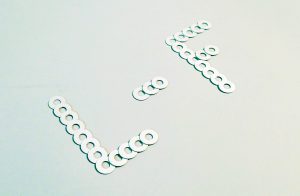Why choose lead-free piezoelectric ceramics?

By Rasmus Lou-Møller
Since the early 1960s, the most important materials for ultrasonic transducers have been piezoelectric ceramics based on the PZT system. However, due to the well-known toxicity of lead, there have been increasing legislative efforts to reduce the use of lead in electronics - at least since the first European ‘RoHS’ directive took affect in 2002. Several countries outside of Europe have implemented similar legislation including China, Japan and South Korea. The exemption protecting PZT in European RoHS is up for revision in 2022.
At present, it looks like the deadlines will be extended another 5 years, but the time it takes to market devices based on lead-free piezoceramics is potentially very long since current lead-free alternatives have different properties than PZT. This means the following 5 years should be spent on testing and evaluating the available lead-free materials in real devices and applications.
The lead-free piezoelectric materials available on the market are not in high demand since PZT-based compositions are considered to have superior performance. In many cases, this is obviously true, but very little effort has been put into designing devices using the available lead-free materials. One of the reasons is that devices on the market today are designed with properties of PZT in mind. Device designers and manufacturers are waiting for a drop-in substitute for PZT and are spending very little effort on designing devices with the lead-free materials in mind. The fact, however, is that a drop-in substitute is not likely to appear in the foreseeable future. Even though some incremental progress has been made in terms of the processing and tuning of compositions, the known lead free base systems like KNN, NBT, BT etc. were discovered a long time ago, and it is unlikely that a breakthrough will occur in the short term.
Even though PZT-based compositions are considered superior to lead free materials, it is important to bear in mind that the lead-free materials have different superior qualities in some areas. For instance, some KNN compositions have higher Curie temperature, and NBT can withstand higher electric fields. Furthermore, the frequency constant for these two materials is also higher than for PZT. If you experience challenges with these issues, it might be a good idea to consider using lead-free piezoelectric materials.
The following is what we can do for you in the process of switching to lead-free materials:

- We offer the possibility to supply samples of lead-free compositions to test in applications.
- Furthermore, we offer assistance in the design phase, contributing with our experience with piezo materials in general. At present, we have two materials on offer for testing Pz12 and Pz12X, both based on NBT. Pz12X has higher d33 than Pz12, but has a lower transition temperature. Pz12 and Pz12X are well suited for high power applications working at room or body temperature.
- We are currently working on compositions based on KNN, and we hope to be able to offer this for testing later in 2022. These materials have higher sensitivity and higher transition temperature. The manufacturability of KNN materials is more challenging, and therefore the cost is higher.
Written by Rasmus Lou-Møller
Director of Engineering and Business Development
 ENGLISH
ENGLISH




























































